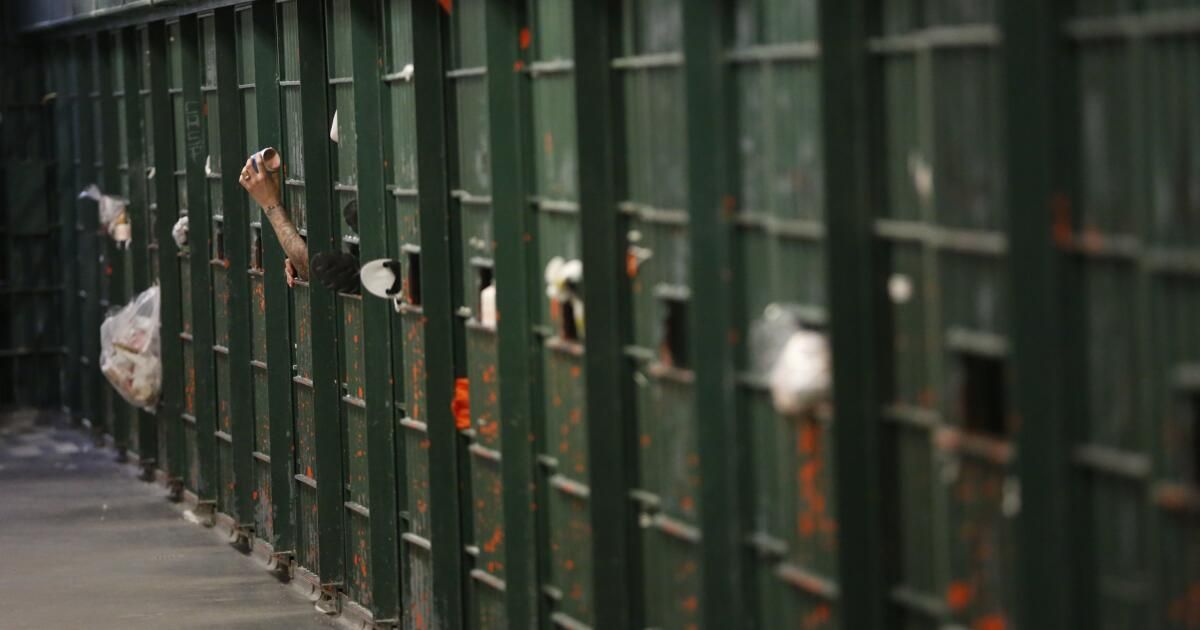There is no disagreement about the proper fate of the Men's Central Jail in downtown Los Angeles. The decrepit facility should be demolished at full speed, as soon as county leaders make alternative arrangements for the thousands of people housed there at any given time.
And that's the crux of the matter: what do we do with all of them, especially the huge percentage of people who ended up in prison partly because of psychiatric or drug-related problems?
For years, the Board of Supervisors clung to the most routine and self-defeating response: build another prison, with a new name that implied a new mindset. It was to be called the Consolidated Correctional Treatment Center, then the Mental Health Treatment Center. The name being considered now is the Care First Treatment Campus.
But all of those fancy labels are just euphemisms for “jail.” They all describe a single, large, secure building, located on the site of the former Men’s Central Jail, surrounded by other jails and staffed by sheriff’s deputies.
The board receives regular reports to monitor the progress of the jail closure, but it does little to meet the various deadlines it sets and then fails to meet them. During last month’s report, Sheriff Robert Luna said that while deputies would be needed at a treatment campus, their role might be limited. The board was noncommittal, though comments from some supervisors could be interpreted as showing renewed openness to a bad idea: a replacement jail.
We've been in this situation before. One of those adjacent jails is Twin Towers, which sounds like it should be a luxury condo complex, but is in fact a jail that has been cited and sued almost as often as Men's Central, which is next door. It became the county's 1990s version of a treatment-oriented center.
As supervisors finally acknowledged in 2019, an even newer jail is not the solution, because the problem is not simply an old, dilapidated building. The problem is that sheriff’s deputies are trained to conduct policing, which is neither the right skill set nor the right approach to rehabilitating people struggling with mental illness and addiction, whether or not those people have been charged with crimes. Mental health professionals have repeatedly testified that law enforcement techniques such as violent cell extractions often worsen patients’ conditions and undermine treatment.
The recent history of Los Angeles County is replete with evidence that law enforcement is the wrong strategy for treating psychiatric patients. For the first decade and a half of this century, jailers routinely beat and abused inmates whose conditions they could not understand. The Sheriff’s Department failed so miserably in providing medical and mental health care that it had to delegate responsibility to county health officials; yet deputies continue to run the facilities and supervise inmates, and overall care remains abysmal.
In the past year alone, jailers have been caught watching pornography on the job instead of monitoring the people they are charged with supervising and helping. Twenty-one people have died in Los Angeles County jails this year, 66 since the beginning of last year. Among the legal agreements that were supposed to improve conditions are one that is nearly a half-century old and another that was signed this year, and many others in between.
Certainly, many psychiatric patients need security, especially in the early stages of treatment. No one wants to let patients wander around alone, but locks alone do not turn treatment into a prison as long as medical standards and practices prevail. Best practices for psychiatric treatment include “lower-level beds,” where patients with more severe problems are subject to the highest security, and increasing levels of freedom over time as treatment and patient improvement allow.
To make smaller-scale care possible, patients would need to be treated close to their home communities, where most will eventually return. That means treatment would need to be provided in small facilities spread across the county, not in a single, massive building in a jail complex.
These principles — a network of small, locked and unlocked transitional facilities, run by medical professionals rather than law enforcement, with security hired as needed — have been part of the county’s primary care plan for years.
That plan is stalled in part because the population at Men’s Central Jail remains too high — about 4,000 people — to close the facility. But the population reduction supervisors said was necessary to close Men’s Central Jail was always intended to come from across the jail system. The county has already made progress toward that milestone with the help of successful county diversion programs that move people away from or out of all county jails.
The Office of Diversion and Reentry, for example, offers community housing and treatment to people deemed incompetent to stand trial and who might otherwise stay in the Twin Towers in the almost futile hope that their conditions will improve there. This is expensive and absurd.
To be more successful, programs like ODR need more beds in more communities. This is a political challenge for the Board of Supervisors because of the usual resistance from residents to such facilities. But supervisors have made progress in housing and treating homeless people, whose profiles are often the same as many sick people currently in prison, except that they have managed to avoid arrest.
They must move forward if they are to fulfill their promise to close the dungeon that is Men's Central Jail and finally break the county's cycle of incarceration and failure rather than treatment and healing.












